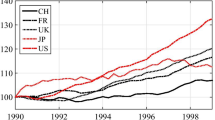Abstract
The paper analyzes the degree of output persistence in GDP in order toempirically discriminate between the Solow growth model, the perfect competition endogenous growth model and the imperfect competition endogenous growth model for the case of Austria. Wefind that a shock in the growth rate of output induces a permanent and larger effect on the level of GDP. This leads us to refute the Solow growth model and the perfect competition model of endogenous growth.We may not reject the imperfect competition growth model.
Similar content being viewed by others
References
Campbell, J.Y. and Mankiw, N.G. (1987) 'Are Output Fluctuations Persistent?', QuarterlyJournal of Economics 102(4), 857–880.
Campbell, J.Y. and Mankiw, N.G. (1989) 'InternationalEvidence on the Persistence of Economic Fluctuations', Journal of Monetary Economics 23(2), 319–333.
Chochrane, J.H. (1995) Shocks, NBER Working Paper No. 4698. Cambridge, MA.
Demery, D. and Duck, N.W. (1992) 'Are Economic Fluctuations Really Persistent? A Reinterpretation of Some International Evidence', Economic Journal 102(414), 1094–1101.
Judge, G., Hill, C., Griffiths, W., Lütkepohl, H. and Lee, T.C. (1988) Introduction to the Theory and Practice of Econometrics. New York: John Wiley & Sons.
Kydland, F.E. and Prescott, E.C. (1982) 'Time to Build and AggregateFluctuations', Econometrica 50, 1345–1370.
Lau, S.-H. P. (1999) 'I(0) In, Integration andCointegration Out: Time Series Properties of Endogenous Growth Models', Journal of Econometrics 93(1), 1–24.
Lucas, R.E. (1988) 'On the Mechanics of Economic Development', Journal of MonetaryEconomy 22(1), 3–42.
Matsuyama, K. (1995) 'Complementarities and Cumulative Processes inModels of Monopolistic Competition', Journal of Economic Literature 33, 701–729.
Neusser, K.(1991) 'Testing the Long-Run Implications of the Neoclassical Growth Model', Journal of Monetary Economics 27(1), 3–37.
Perron, P. (1990) Further Evidence on Break Trend Functions inMacroeconomic Variables, mimeo, Princeton.
Perron, P. (1993) 'The Hump-Shaped Behavior ofMacroeconomic Fluctuations', Empirical Economics 18(4), 707–728.
Pischke, J.S. (1991)'Measuring Persistence in the Presence of Trend Breaks', Economics Letters 36(4), 379–384.
Romer, P.M. (1986) 'Increasing Returns and Long-Run Growth', Journal of Political Economy 94,1002–1035.
Romer, P.M. (1990) 'Endogenous Technological Change', Journal of Political Economy 98, 71–102.
Rünstler, G. (1994) 'The Long-Run Impact of Foreign Shocks to the Austrian Economy:An Analysis at a Sectoral Level', Applied Economics 26, 803–813.
Solow, R.M. (1956) 'AContribution to the Theory of Economic Growth', Quarterly Journal of Economics 71, 65–94.
Url, Th. and Wehinger G. (1990) 'The Nature of Austrian Macroeconomic Time Series', Empirica 17(2), 131–154.
WIFO, Volkswirtschaftliche Datenbank (Economic Database),http://www.wifo.ac.at/cgi-bin/wzrp/wzrphome.cgi, August 1998.
Author information
Authors and Affiliations
Rights and permissions
About this article
Cite this article
Ragacs, C., Zagler, M. Persistence of Shocks to Output in Austria and Theories of Economic Growth. Empirica 29, 305–317 (2002). https://doi.org/10.1023/A:1020851321085
Issue Date:
DOI: https://doi.org/10.1023/A:1020851321085




